Coordination of Multiple BESS Units in a Low-Voltage Distribution Network Using Leader–Follower and Leaderless Control
Abstract
1. Introduction
1.1. Relevant Literature
1.2. Contributions
- Many works focus on optimal sizing and placing of energy storage systems instead of using available resources; however, most DSOs cannot own energy storage assets due to regulation limitations.
- Most of aggregation strategies in the literature focus on medium- and high-voltage networks; however, low-voltage networks are particularly critical for the energy transition. They do not have ancillary services providers to support the DSO, and the demand increase caused by heating electrification and electric mobility can potentially cause major voltage challenges. In addition, existing control strategies focus on reactive power-based voltage control. This is because the reactive component in the impedance is dominant in medium- and high-voltage networks, whereas low-voltage networks have mostly resistive line impedances.
- Existing aggregation strategies require full observability of all assets; in real implementations, this would require complex communication infrastructure and controls, leading to scalability bottlenecks.
- A scalable control strategy that reaches consensus when voltage is regulated within the limits; thus, the algorithm is terminated as soon as voltage is regulated as opposed to when all batteries agree on the same amount of power contribution to the system,
- The of each battery is controlled locally; when the limit of the is reached, the battery is instantly disconnected. Neighbouring batteries contribute the same amount of power that the battery would contribute if it were available until the battery becomes available for use again. This allows multiple BESS units to be balanced while respecting their SoC constraints.
- An approach that provides less communication requirements compared to traditional distributed control implementations, as each agent only shares information with its neighbours, thereby reducing the infrastructure requirements and simplifying data privacy management.
2. Consensus Algorithm
3. CIGRE LV Network
4. Leader–Follower Coordination Strategy
4.1. Control Method and Algorithm
4.2. Results
5. Leaderless Coordination Strategy
5.1. Control Method and Algorithm
5.2. Results
6. Discussion
7. Conclusions
Author Contributions
Funding
Data Availability Statement
Conflicts of Interest
References
- IEA. Renewable Electricity Growth Is Accelerating Faster than Ever Worldwide, Supporting the Emergence of the New Global Energy Economy; Technical Report; International Energy Agency: Paris, France, 2021. [Google Scholar]
- Hemetsberger, W.; Schmela, M.; Chianetta, G. Global Market Outlook For Solar Power; Technical Report; SolarPower Europe: Brussels, Belgium, 2022. [Google Scholar]
- Nhede, N. Solar to Cover a Quarter of Global Power by 2050; Technical Report; SolarPower Europe: Brussels, Belgium, 2022. [Google Scholar]
- Balasubramanian, S.; Balachandra, P. Effectiveness of demand response in achieving supply-demand matching in a renewables dominated electricity system: A modelling approach. Renew. Sustain. Energy Rev. 2021, 147, 111245. [Google Scholar] [CrossRef]
- Mertens, S. Design of wind and solar energy supply, to match energy demand. Clean. Eng. Technol. 2022, 6, 100402. [Google Scholar] [CrossRef]
- Alpízar-Castillo, J.; Ramírez-Elizondo, L.; Bauer, P. The Effect of Non-Coordinated Heating Electrification Alternatives on a Low-Voltage Distribution Network with High PV Penetration. In Proceedings of the 2023 IEEE 17th International Conference on Compatibility, Power Electronics and Power Engineering (CPE-POWERENG), Tallinn, Estonia, 14–16 June 2023; pp. 1–6. [Google Scholar] [CrossRef]
- Alpízar-Castillo, J.; Ramirez-Elizondo, L.; Bauer, P. Assessing the Role of Energy Storage in Multiple Energy Carriers toward Providing Ancillary Services: A Review. Energies 2023, 16, 379. [Google Scholar] [CrossRef]
- Zhu, N.; Hu, P.; Jiang, C.; Yu, Y.; Jiang, D. Comparative analysis and optimal allocation of virtual inertia from grid-forming and grid-following controlled ESSs. IET Renew. Power Gener. 2024, 18, 2416–2429. [Google Scholar] [CrossRef]
- Xie, L.; Xiang, Y.; Xu, X.; Wang, S.; Li, Q.; Liu, F.; Liu, J. Optimal Planning of Energy Storage in Distribution Feeders Considering Economy and Reliability. Energy Technol. 2024, 12, 2400200. [Google Scholar] [CrossRef]
- Shafiekhani, M.; Qadrdan, M. Addressing electricity transmission network congestions using battery energy storage systems—A case study of great Britain. Appl. Energy 2025, 384, 125418. [Google Scholar] [CrossRef]
- An, J.; Hong, T. Multi-objective optimization for optimal placement of shared battery energy storage systems in urban energy communities. Sustain. Cities Soc. 2025, 120, 106178. [Google Scholar] [CrossRef]
- An, J.; Hong, T. Optimizing battery energy storage system placement in energy intensive cities for sustainable urban development considering multiple objectives. Sustain. Cities Soc. 2025, 118, 106036. [Google Scholar] [CrossRef]
- Nour, A.M.; Helal, A.A.; El-Saadawi, M.M.; Hatata, A.Y. A control scheme for voltage unbalance mitigation in distribution network with rooftop PV systems based on distributed batteries. Int. J. Electr. Power Energy Syst. 2021, 124, 106375. [Google Scholar] [CrossRef]
- Samende, C.; Bhagavathy, S.M.; McCulloch, M. Power Loss Minimization of Off-Grid Solar DC Nano-Grids—Part I: Centralized Control Algorithm. IEEE Trans. Smart Grid 2021, 12, 4715–4725. [Google Scholar] [CrossRef]
- Wang, L.; Liang, D.H.; Crossland, A.F.; Taylor, P.C.; Jones, D.; Wade, N.S. Coordination of Multiple Energy Storage Units in a Low-Voltage Distribution Network. IEEE Trans. Smart Grid 2015, 6, 2906–2918. [Google Scholar] [CrossRef]
- Byrne, R.H.; Nguyen, T.A.; Copp, D.A.; Chalamala, B.R.; Gyuk, I. Energy Management and Optimization Methods for Grid Energy Storage Systems. IEEE Access 2018, 6, 13231–13260. [Google Scholar] [CrossRef]
- Tonkoski, R.; Lopes, L.A.C.; El-Fouly, T.H.M. Coordinated Active Power Curtailment of Grid Connected PV Inverters for Overvoltage Prevention. IEEE Trans. Sustain. Energy 2011, 2, 139–147. [Google Scholar] [CrossRef]
- Bahramipanah, M.; Torregrossa, D.; Cherkaoui, R.; Paolone, M. A Decentralized Adaptive Model-Based Real-Time Control for Active Distribution Networks Using Battery Energy Storage Systems. IEEE Trans. Smart Grid 2018, 9, 3406–3418. [Google Scholar] [CrossRef]
- Nour, A.M.M.; Helal, A.A.; El-Saadawi, M.M.; Hatata, A.Y. Voltage imbalance mitigation in an active distribution network using decentralized current control. Prot. Control Mod. Power Syst. 2023, 8, 20. [Google Scholar] [CrossRef]
- Procopiou, A.T.; Petrou, K.; Ochoa, L.F.; Langstaff, T.; Theunissen, J. Adaptive Decentralized Control of Residential Storage in PV-Rich MV–LV Networks. IEEE Trans. Power Syst. 2019, 34, 2378–2389. [Google Scholar] [CrossRef]
- Khan, M.H.; Zulkifli, S.A.; Tutkun, N.; Burgio, A. Adaptive Virtual Impedance Control with MPC’s Cost Function for DG Inverters in a Microgrid with Mismatched Feeder Impedances for Future Energy Communities. Sustainability 2024, 16, 525. [Google Scholar] [CrossRef]
- Wang, L.; Dubey, A.; Gebremedhin, A.H.; Srivastava, A.K.; Schulz, N. MPC-Based Decentralized Voltage Control in Power Distribution Systems with EV and PV Coordination. IEEE Trans. Smart Grid 2022, 13, 2908–2919. [Google Scholar] [CrossRef]
- Then, J.; Agalgaonkar, A.P.; Muttaqi, K.M. Coordinated Charging of Spatially Distributed Electric Vehicles for Mitigating Voltage Rise and Voltage Unbalance in Modern Distribution Networks. IEEE Trans. Ind. Appl. 2023, 59, 5149–5157. [Google Scholar] [CrossRef]
- Yu, H.; Xu, C.; Wang, W.; Geng, G.; Jiang, Q. Communication-Free Distributed Charging Control for Electric Vehicle Group. IEEE Trans. Smart Grid 2023, 15, 3028–3039. [Google Scholar] [CrossRef]
- Anderson, T.; Muralidharan, M.; Srivastava, P.; Haghi, H.V.; Cortés, J.; Kleissl, J.; Martínez, S.; Washom, B. Frequency Regulation with Heterogeneous Energy Resources: A Realization Using Distributed Control. IEEE Trans. Smart Grid 2021, 12, 4126–4136. [Google Scholar] [CrossRef]
- Zhao, T.; Parisio, A.; Milanović, J.V. Location-dependent distributed control of battery energy storage systems for fast frequency response. Int. J. Electr. Power Energy Syst. 2021, 125, 106493. [Google Scholar] [CrossRef]
- Morstyn, T.; Savkin, A.V.; Hredzak, B.; Agelidis, V.G. Multi-Agent Sliding Mode Control for State of Charge Balancing Between Battery Energy Storage Systems Distributed in a DC Microgrid. IEEE Trans. Smart Grid 2018, 9, 4735–4743. [Google Scholar] [CrossRef]
- Xia, S.; Bu, S.; Wan, C.; Lu, X.; Chan, K.W.; Zhou, B. A Fully Distributed Hierarchical Control Framework for Coordinated Operation of DERs in Active Distribution Power Networks. IEEE Trans. Power Syst. 2019, 34, 5184–5197. [Google Scholar] [CrossRef]
- Nguyen, D.H.; Khazaei, J. Unified Distributed Control of Battery Storage with Various Primary Control in Power Systems. IEEE Trans. Sustain. Energy 2021, 12, 2332–2341. [Google Scholar] [CrossRef]
- Meng, T.; Lin, Z.; Wan, Y.; Shamash, Y.A. State-of-Charge Balancing for Battery Energy Storage Systems in DC Microgrids by Distributed Adaptive Power Distribution. IEEE Control Syst. Lett. 2022, 6, 512–517. [Google Scholar] [CrossRef]
- Engels, J.; Claessens, B.; Deconinck, G. Grid-Constrained Distributed Optimization for Frequency Control with Low-Voltage Flexibility. IEEE Trans. Smart Grid 2020, 11, 612–622. [Google Scholar] [CrossRef]
- Zhang, Z.; Dou, C.; Yue, D.; Xue, Y.; Xie, X.; Deng, C.; Zhang, B. Voltage Sensitivity-Related Hybrid Coordinated Power Control for Voltage Regulation in ADNs. IEEE Trans. Smart Grid 2024, 15, 1388–1398. [Google Scholar] [CrossRef]
- Gao, Y.; Wang, W.; Yu, N. Consensus Multi-Agent Reinforcement Learning for Volt-VAR Control in Power Distribution Networks. IEEE Trans. Smart Grid 2021, 12, 3594–3604. [Google Scholar] [CrossRef]
- Long, Y.; Elliott, R.T.; Kirschen, D.S. Adaptive Coalition Formation-Based Coordinated Voltage Regulation in Distribution Networks. IEEE Trans. Power Syst. 2022, 37, 2005–2018. [Google Scholar] [CrossRef]
- Jasim, A.M.; Jasim, B.H.; Aymen, F.; Kotb, H.; Althobaiti, A. Consensus-based intelligent distributed secondary control for Multiagent Islanded Microgrid. Int. Trans. Electr. Energy Syst. 2023, 2023, 6812351. [Google Scholar] [CrossRef]
- Amirkhani, A.; Barshooi, A.H. Consensus in multi-agent systems: A review. Artif. Intell. Rev. 2022, 55, 3897–3935. [Google Scholar] [CrossRef]
- Olfati-Saber, R.; Fax, J.A.; Murray, R.M. Consensus and Cooperation in Networked Multi-Agent Systems. Proc. IEEE 2007, 95, 215–233. [Google Scholar] [CrossRef]
- Zeraati, M.; Hamedani Golshan, M.E.; Guerrero, J.M. Distributed Control of Battery Energy Storage Systems for Voltage Regulation in Distribution Networks with High PV Penetration. IEEE Trans. Smart Grid 2018, 9, 3582–3593. [Google Scholar] [CrossRef]
- Wang, Y.; Tan, K.T.; Peng, X.Y.; So, P.L. Coordinated Control of Distributed Energy-Storage Systems for Voltage Regulation in Distribution Networks. IEEE Trans. Power Deliv. 2016, 31, 1132–1141. [Google Scholar] [CrossRef]
- Specialized Power Systems. 2025. Available online: https://www.mathworks.com/help/sps/specialized-power-systems.html (accessed on 15 August 2025).
- PV Array—Simscape Electrical Specialized Power Systems (Renewables). Available online: https://nl.mathworks.com/help/sps/powersys/ref/pvarray.html (accessed on 19 August 2025).
- Battery—Simscape Electrical Specialized Power Systems (Renewables). Available online: https://nl.mathworks.com/help/sps/powersys/ref/battery.html (accessed on 19 August 2025).
- Gantenbein, S.; Schönleber, M.; Weiss, M.; Ivers-Tiffée, E. Capacity Fade in Lithium-Ion Batteries and Cyclic Aging over Various State-of-Charge Ranges. Sustainability 2019, 11, 6697. [Google Scholar] [CrossRef]

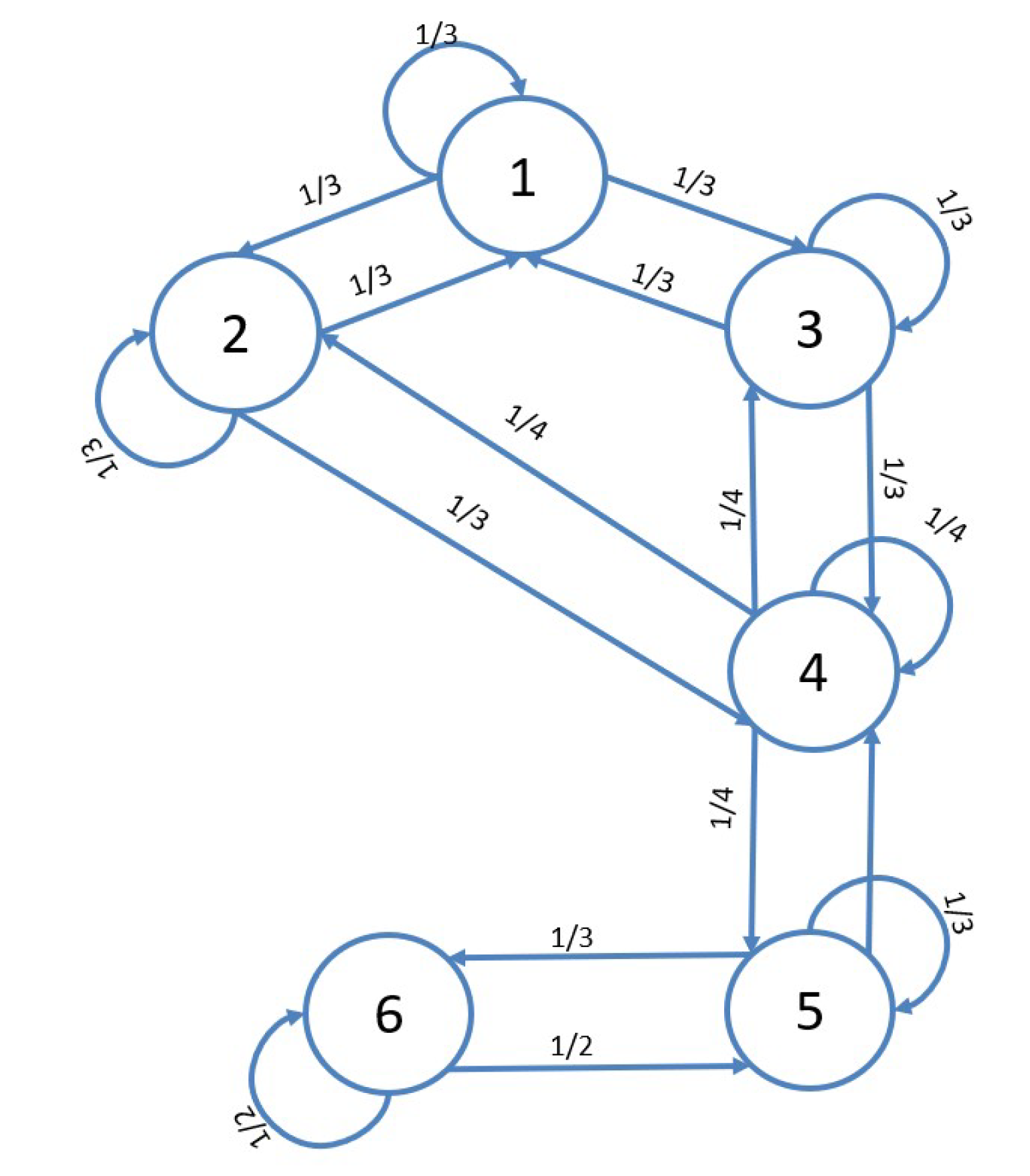

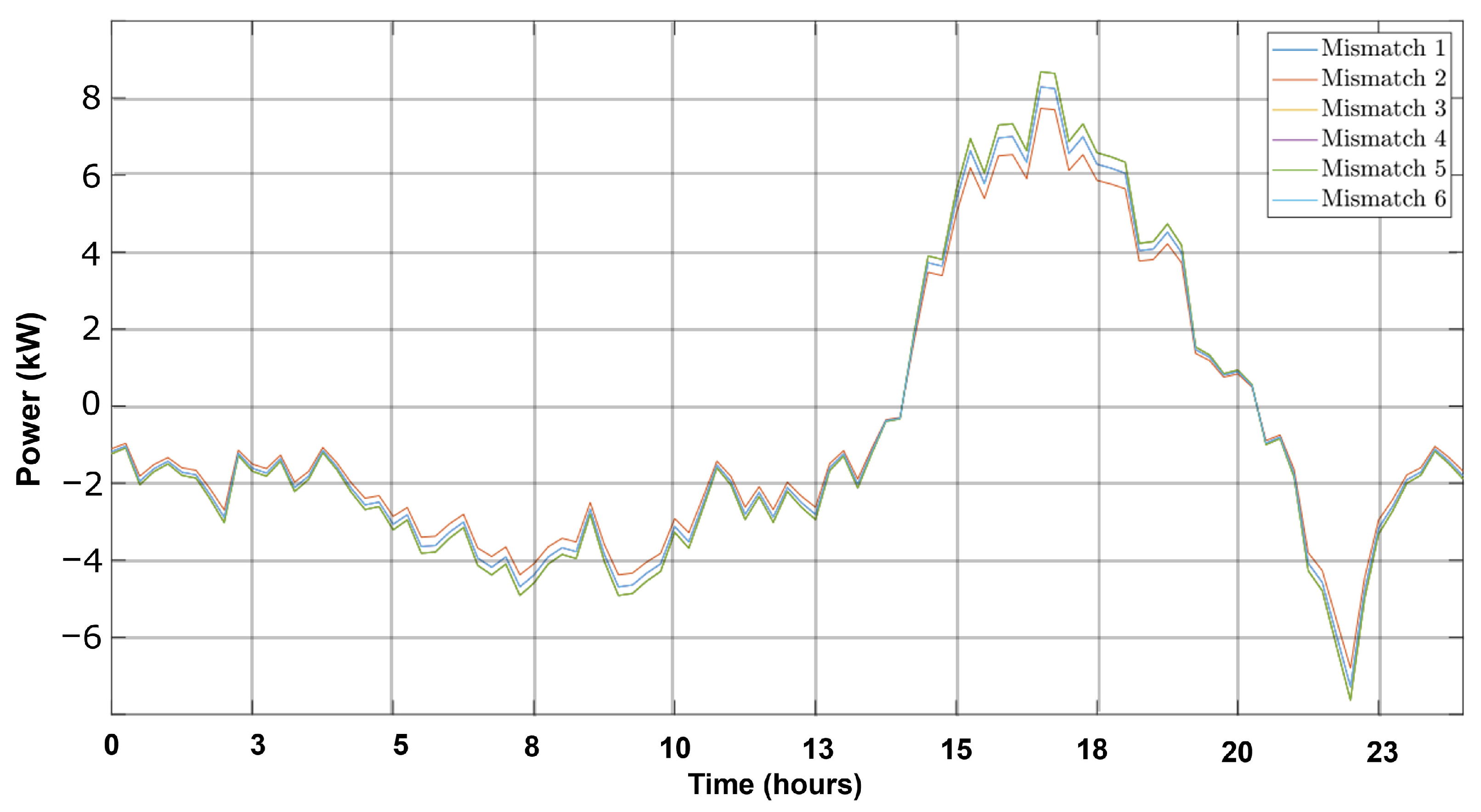
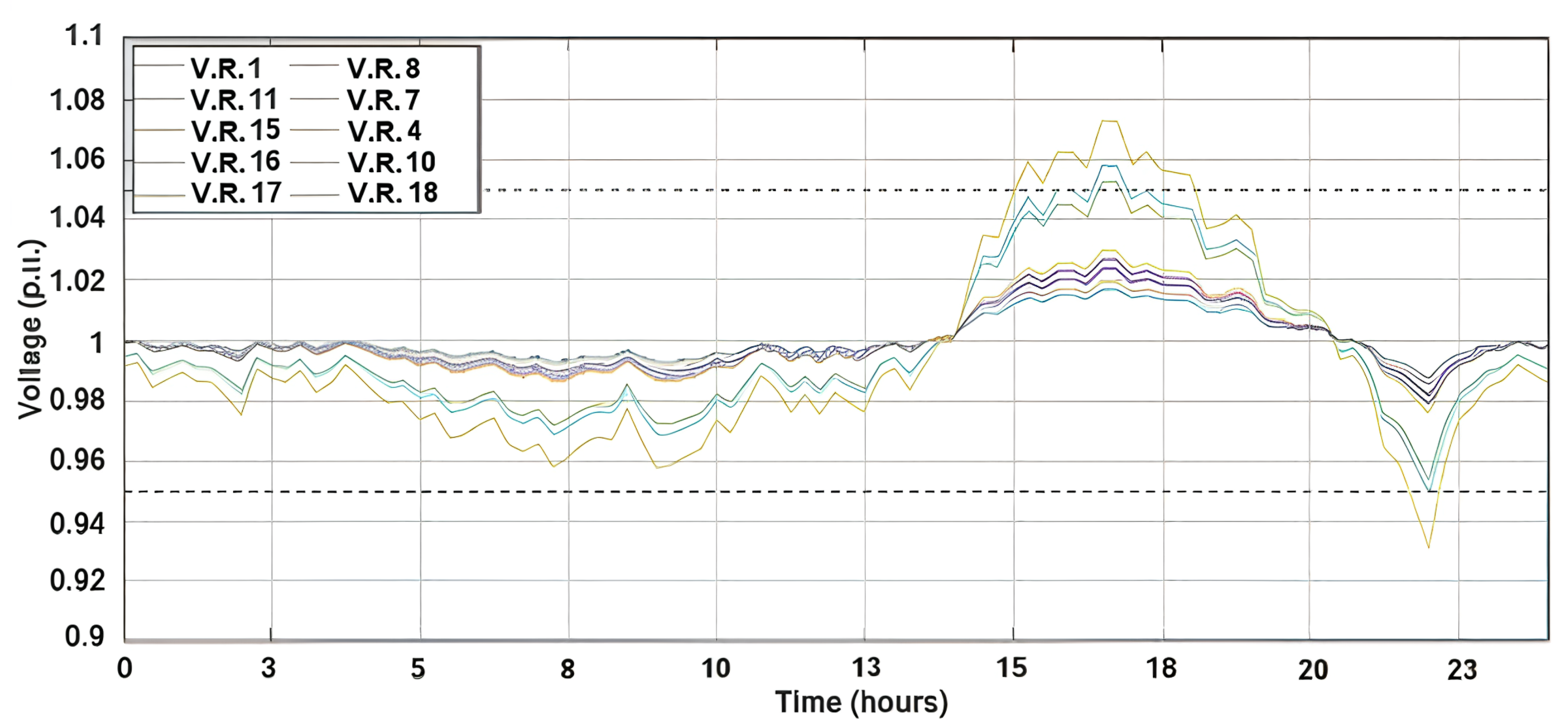
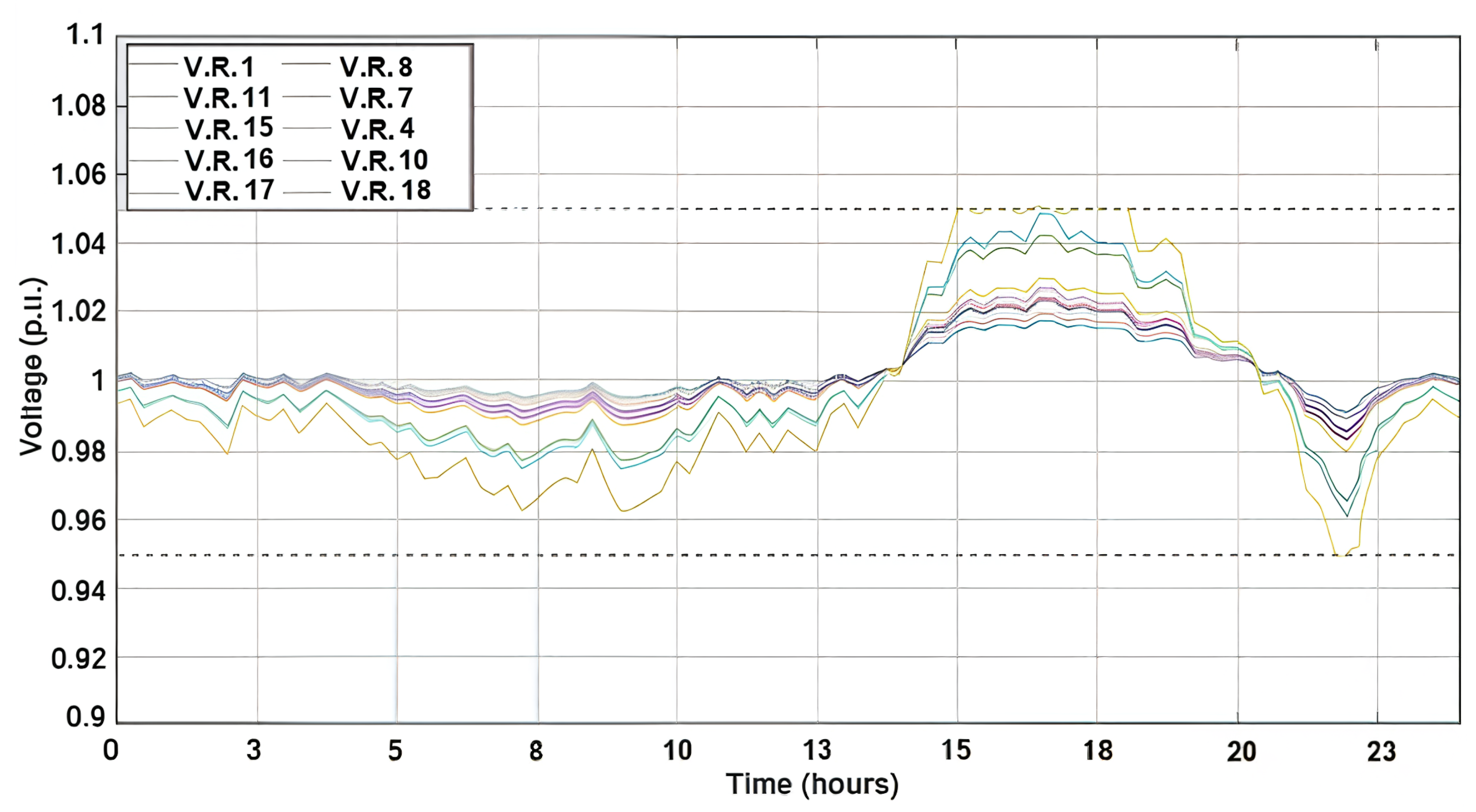



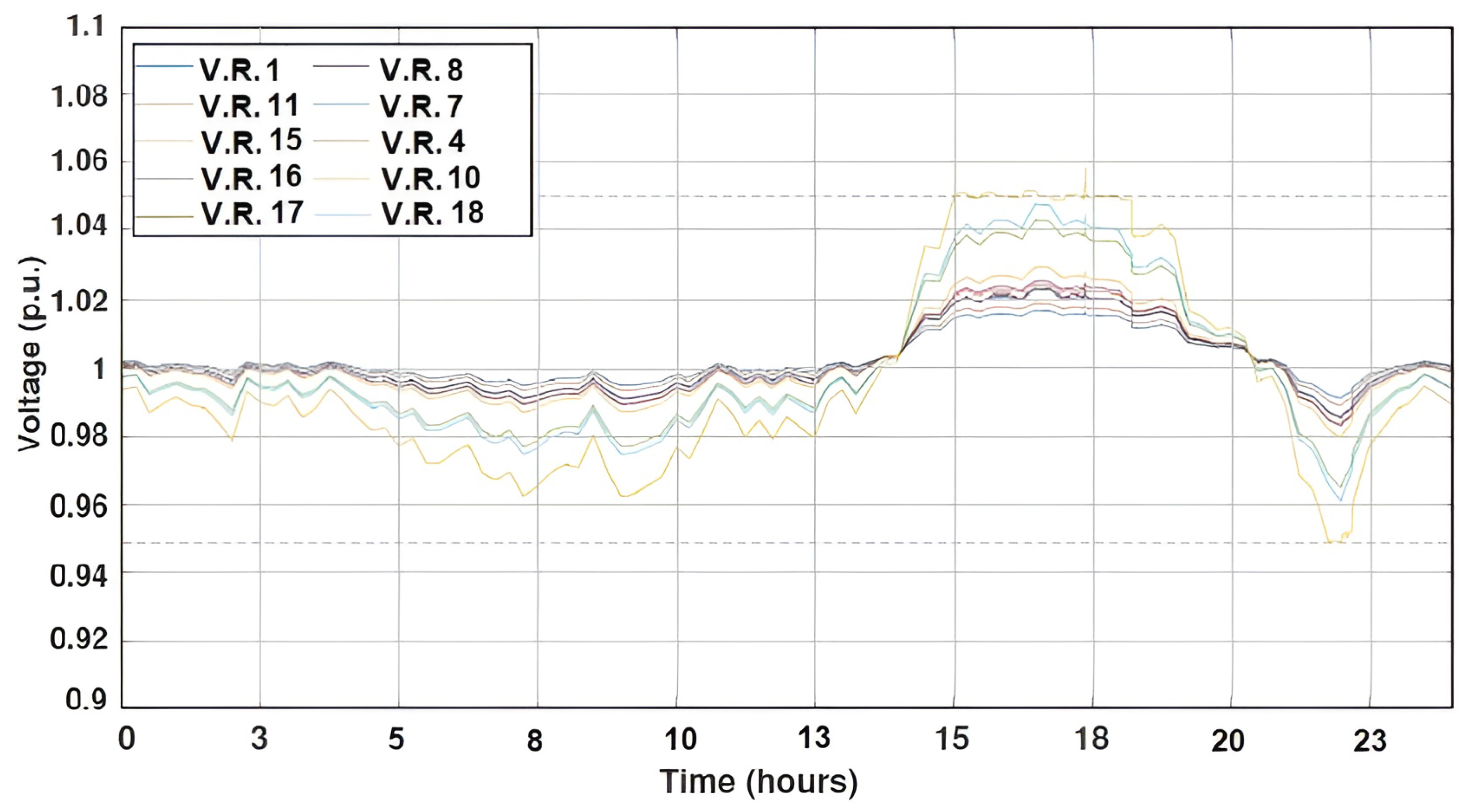



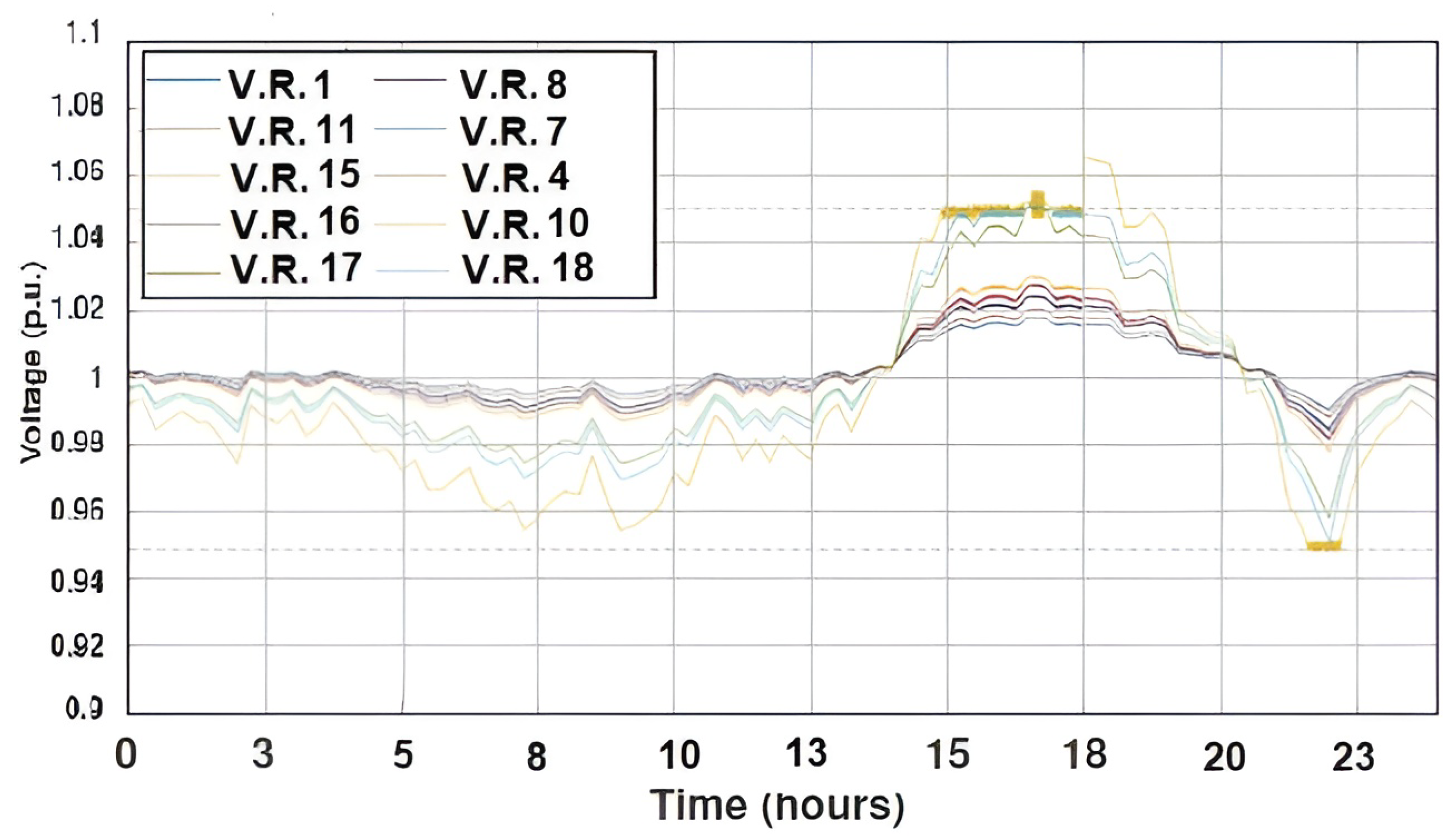
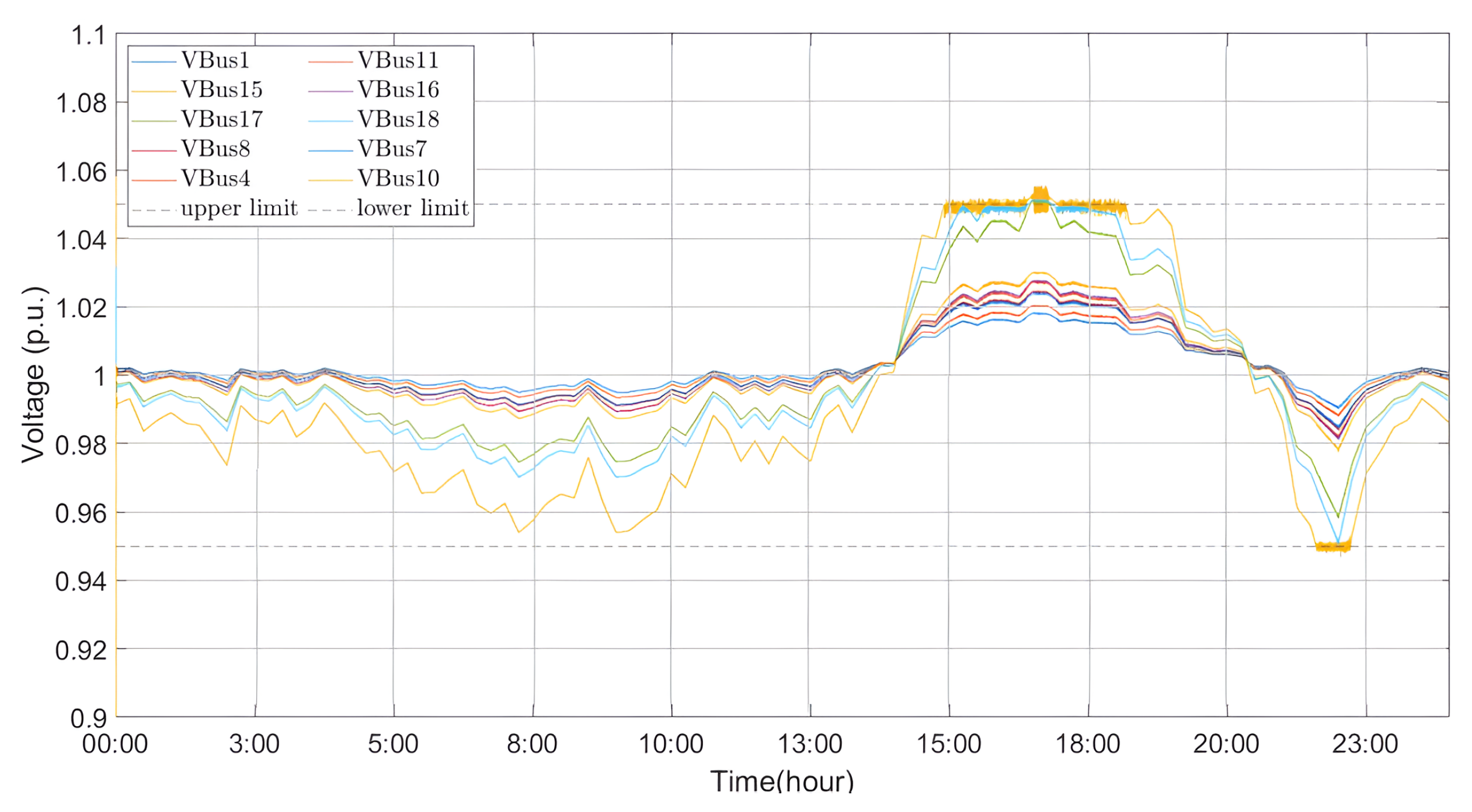





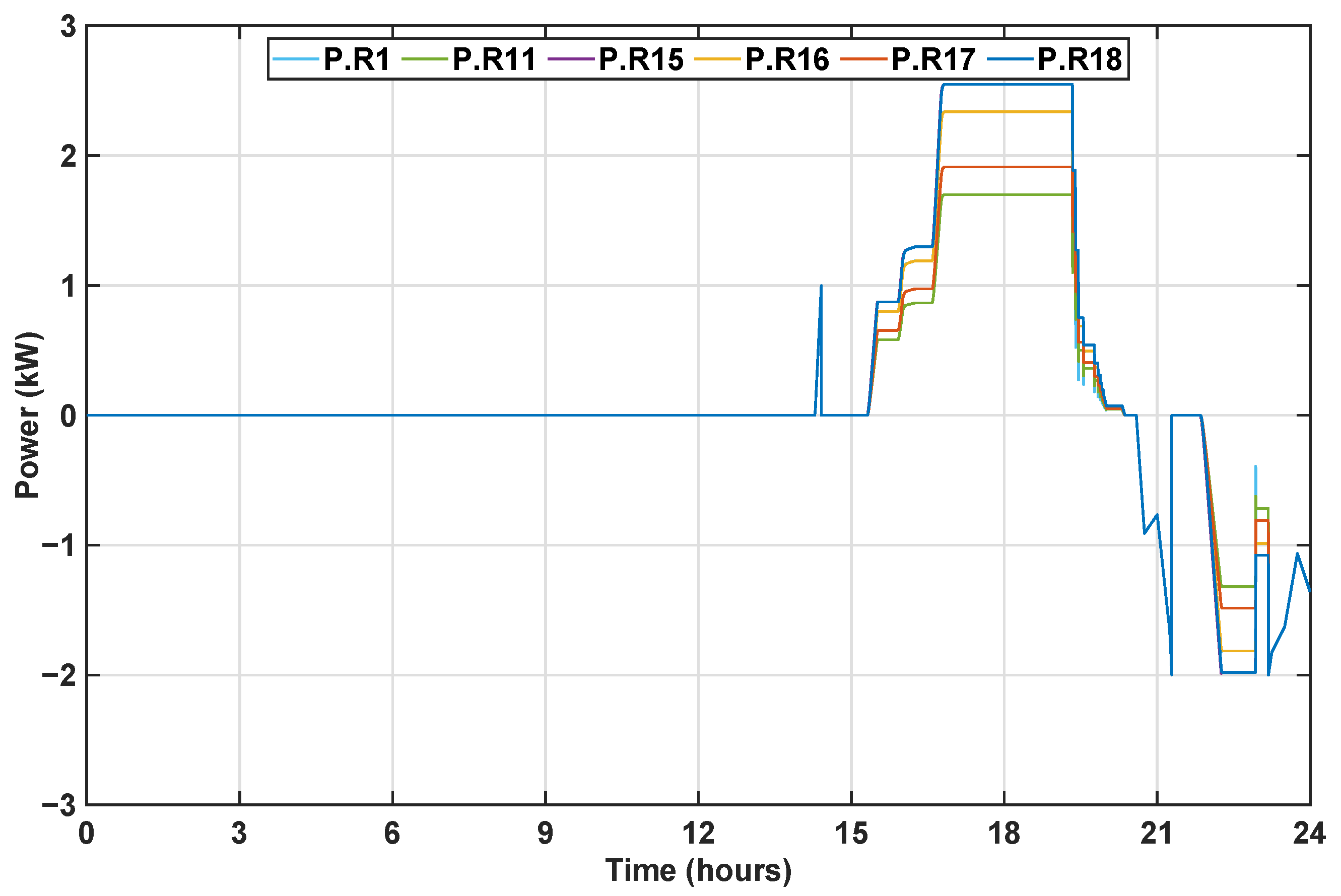

| Identified Research Gap | Reference | ||
|---|---|---|---|
| DSO Asset Ownership | MV or HV Oriented | Full Observability | |
| X | X | X | [8] |
| X | X | X | [9] |
| X | X | X | [10] |
| X | X | [11] | |
| X | X | [12] | |
| X | X | [13] | |
| X | X | X | [14] |
| X | X | X | [16] |
| X | [17] | ||
| X | X | [18] | |
| X | [19] | ||
| X | [20] | ||
| X | [21] | ||
| X | X | [22] | |
| X | X | [23] | |
| X | [25] | ||
| X | X | [26] | |
| X | X | X | [28] |
| X | X | [29] | |
| X | [31] | ||
| X | X | [32] | |
| X | X | X | [33] |
| Node | BESS Agent | PPV [kW] | PBESS [kW] | EBESS [kWh] |
|---|---|---|---|---|
| 1 | 1 | 11 | 5.5 | 38 |
| 11 | 2 | 9 | 4 | 30 |
| 15 | 3 | 12 | 6 | 40 |
| 16 | 4 | 11 | 5.5 | 38 |
| 17 | 5 | 9.5 | 4.5 | 32 |
| 18 | 6 | 12 | 6 | 40 |
Disclaimer/Publisher’s Note: The statements, opinions and data contained in all publications are solely those of the individual author(s) and contributor(s) and not of MDPI and/or the editor(s). MDPI and/or the editor(s) disclaim responsibility for any injury to people or property resulting from any ideas, methods, instructions or products referred to in the content. |
© 2025 by the authors. Licensee MDPI, Basel, Switzerland. This article is an open access article distributed under the terms and conditions of the Creative Commons Attribution (CC BY) license (https://creativecommons.org/licenses/by/4.0/).
Share and Cite
Kitso, M.; Priambodo, B.I.; Alpízar-Castillo, J.; Ramírez-Elizondo, L.; Bauer, P. Coordination of Multiple BESS Units in a Low-Voltage Distribution Network Using Leader–Follower and Leaderless Control. Energies 2025, 18, 4566. https://doi.org/10.3390/en18174566
Kitso M, Priambodo BI, Alpízar-Castillo J, Ramírez-Elizondo L, Bauer P. Coordination of Multiple BESS Units in a Low-Voltage Distribution Network Using Leader–Follower and Leaderless Control. Energies. 2025; 18(17):4566. https://doi.org/10.3390/en18174566
Chicago/Turabian StyleKitso, Margarita, Bagas Ihsan Priambodo, Joel Alpízar-Castillo, Laura Ramírez-Elizondo, and Pavol Bauer. 2025. "Coordination of Multiple BESS Units in a Low-Voltage Distribution Network Using Leader–Follower and Leaderless Control" Energies 18, no. 17: 4566. https://doi.org/10.3390/en18174566
APA StyleKitso, M., Priambodo, B. I., Alpízar-Castillo, J., Ramírez-Elizondo, L., & Bauer, P. (2025). Coordination of Multiple BESS Units in a Low-Voltage Distribution Network Using Leader–Follower and Leaderless Control. Energies, 18(17), 4566. https://doi.org/10.3390/en18174566








